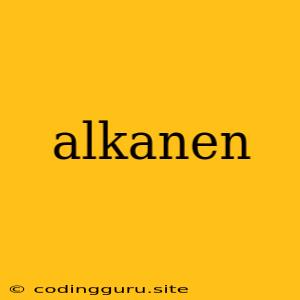What are Alkanes?
Alkanes are the simplest type of organic compound, consisting solely of hydrogen and carbon atoms. They are known as saturated hydrocarbons, meaning they contain only single bonds between carbon atoms. This structure gives alkanes their characteristic properties, including:
- Nonpolarity: Alkanes are nonpolar due to the equal sharing of electrons between the carbon and hydrogen atoms. This nonpolarity makes them generally unreactive with polar compounds like water.
- Combustibility: Alkanes readily burn in the presence of oxygen, releasing heat and light. This property makes them excellent fuels, like methane (natural gas) and propane.
- Low Reactivity: Alkanes are relatively unreactive compared to other organic molecules. Their stability stems from the strong single bonds between carbon and hydrogen atoms.
Naming Alkanes: A Systematic Approach
To understand the structure and properties of alkanes, we need a systematic way to name them. The International Union of Pure and Applied Chemistry (IUPAC) has established a set of rules for naming organic compounds, including alkanes:
- Identify the longest continuous carbon chain: This chain forms the base name of the alkane.
- Number the carbon atoms: Start numbering from the end closest to a substituent (a group attached to the main chain).
- Identify and name substituents: These are groups attached to the main chain. Common substituents include methyl (CH3), ethyl (CH2CH3), propyl (CH2CH2CH3), etc.
- Locate substituents by number: Use the number of the carbon atom to which the substituent is attached.
- Combine the information: Prefixes indicate the number of each substituent (di-, tri-, tetra-, etc.), followed by the names of the substituents, then the base name of the alkane.
Example:
- CH3CH2CH2CH3: This alkane has four carbon atoms in a continuous chain. It is called butane.
- CH3CH2CH(CH3)CH3: This alkane has four carbon atoms in the longest chain, with a methyl group attached to the third carbon. It is called 2-methylbutane.
Different Types of Alkanes: Straight-Chain vs. Branched-Chain
Straight-chain alkanes have all their carbon atoms connected in a single, continuous line. Examples include:
- Methane (CH4)
- Ethane (CH3CH3)
- Propane (CH3CH2CH3)
- Butane (CH3CH2CH2CH3)
Branched-chain alkanes have one or more branches off the main carbon chain. Examples include:
- Isobutane (CH3CH(CH3)CH3)
- Neopentane (CH3C(CH3)3)
Alkanes: Their Roles and Applications
Alkanes play vital roles in our daily lives, contributing to energy production, transportation, and various industries:
- Fuels: Methane, propane, and butane are major components of natural gas and liquefied petroleum gas (LPG), providing energy for heating, cooking, and transportation.
- Petrochemicals: Alkanes are processed into various petrochemicals, such as plastics, synthetic fibers, and detergents.
- Solvents: Some alkanes, like hexane and heptane, are used as solvents in various industrial processes.
- Lubricants: Higher molecular weight alkanes are used as lubricants to reduce friction between moving parts.
Conclusion
Alkanes, the fundamental building blocks of organic chemistry, are ubiquitous in our world, contributing significantly to our energy needs and industrial processes. Understanding their structure, naming conventions, and reactivity allows us to harness their properties for various applications.
